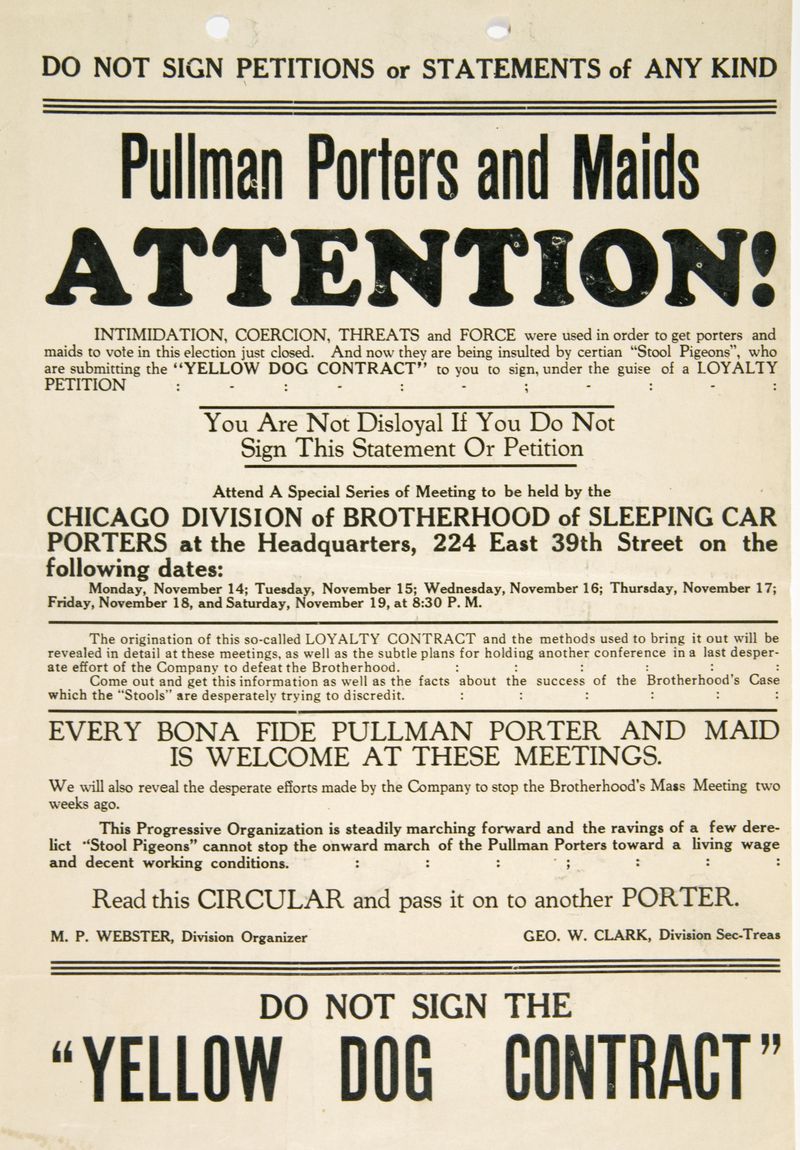Brotherhood of Sleeping Car Porters Rally Posters

Date: 1926 & 1937
Caption: These two posters are promoting labor rallies organized by the Brotherhood of Sleeping Car Porters in 1926 and 1937. A. Philip Randolph led the founding of the Brotherhood of Sleeping Car Porters in 1925, and he became the labor union’s first president. The Brotherhood of Sleeping Car Porters was a union of African American workers that struggled for better working conditions and challenged white supremacy in the nation’s labor movement.
Asa Phillip Randolph was born in Crescent City, Florida in 1889. The vibrant Black community in Jacksonville, Florida, where his family moved early in his life, provided him with a powerful education and close-knit community.1 However, the systemic violence of the Jim Crow South and its limited economic opportunity compelled Randolph to migrate to New York City in 1911 in pursuit of greater opportunity. He took on various jobs while living in New York and enrolled in some courses at City College.
In New York City, Randolph also developed a socialist politics in which he believed that as long as people faced economic precarity and uncertainty, they could not be free. His politics, undoubtedly shaped by the close-knit Black community where he grew up, shaped a new vision of activism predicated upon collective action. In 1917, Randolph began taking leadership roles in the labor movement. His most famous and successful role was as president of the Brotherhood of Sleeping Car Porters (BSCP). The BSCP elected him as president in 1925. The union was composed of porters. Porters worked in sleeping cars on trains, and their responsibilities included carrying passengers’ baggage, shining shoes, preparing passengers’ sleeping arrangements, and other services. Porters often worked long and grueling hours (one reporter estimated they worked nearly 400 hours a month to earn a basic wage), and they often were required to work unpaid hours during which they prepared meals and cleaned up afterwards.2
These exhausting and inhumane working conditions were products of the Pullman Company’s racist business practices. The Pullman Company was one of the largest employers of Black workers in the country, and it used that fact to drive down wages and justify terrible working conditions for its largely Black porters. As head of the BSCP, Randolph organized porters to challenge Pullman’s racist business practices and improve their wages and working conditions. Randolph’s analysis of racism’s economic dimensions and his organizing tactics helped shape the Black Freedom Struggle in the twentieth century.3
The two rally posters above show some of Randolph’s organizing techniques in the BSCP’s early years. For instance, the call for porters (men) and maids (women) demonstrate Randolph’s commitment to include women workers in its organizing. The location of rallies at community institutions like schools also illustrate how Randolph sought to organize wherever workers were.
-
While segregated Black schools were often underfunded and victims of white vigilante violence, Black teachers, principals, and parents worked hard to provide supportive learning environments for children. See Vanessa Siddle Walker, Their Highest Potential: An African American School Community in the Segregated South (Chapel Hill: University of North Carolina Press, 1996) and Jarvis Givens, Fugitive Pedagogy: Carter G. Woodson and the Art of Black Teaching (Cambridge, MA: Harvard University Press, 2021). ↩︎
-
Edward Berman, “The Pullman Porters Win,” The Nation, August 21, 1935. ↩︎
-
For more on the life of A. Philip Randolph, see Cornelius L. Bynum, A. Philip Randolph and the Struggle for Civil Rights (Champaign: University of Illinois Press, 2010). ↩︎
Categories: national
Tags: labor unions, organizing, employment
This item is part of "Before the Boycotts: Organizing and Direct Action" in "Boycotting New York’s Segregated Schools"
Item Details
Date: 1926 & 1937
Creator: Brotherhood of Sleeping Car Porters
Source: Newberry Library
Copyright: Public domain
How to cite: “Brotherhood of Sleeping Car Porters Rally Posters,” Brotherhood of Sleeping Car Porters, in New York City Civil Rights History Project, Accessed: [Month Day, Year], https://nyccivilrightshistory.org/gallery/brotherhood-of-sleeping-car-porters.
Questions to Consider
- What were some of the key ideas that defined A. Philip Randolph’s politics?
- What do you notice about the labor rally posters? What do you wonder?
- Based on the texts and images in the posters, how do you think Randolph and other leaders of the Brotherhood of Sleeping Car Porters persuaded workers to engage in collective struggle? How did they try to get others interested?
References
How to Print this Page
- Press Ctrl + P or Cmd + P to open the print dialogue window.
- Under settings, choose "display headers and footers" if you want to print page numbers and the web address.
- Embedded PDF files will not print as part of the page. For best printing results, download the PDF and print from Adobe Reader or Preview.
